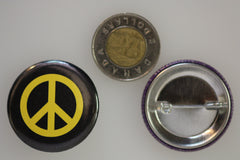A short history of pin-back buttons - The Button Guy Blog.
Share
What is a pin-back button?
Wikipedia: A pin-back button or pinback button, pin button, button badge or simply pin-back, is a button or badge that can be temporarily fastened to the surface of a garment using a safety pin, or a pin formed from wire, a clutch or other mechanism. This fastening mechanism is anchored to the back side of a button-shaped metal disk, either flat or concave, which leaves an area on the front of the button to carry an image or printed message. The word is commonly associated with a campaign button used in the United States and abroad during a political campaign. The first design for a pin-back button in the United States was patented in 1896, and contemporary buttons have many of the same design features.
But I think Wikipedia doesn't really clinch it. A button is a messaging tool, a person to person communications device. A button maker is having your own printing press. You can comment on issues on a day to day basis and sit on the subway a month later and see someone wearing your message. A button is a small canvas for ordinary people to express themselves. A button can be the weapon of the oppressed or a quiet form of passive resistance.
History of pin-back buttons.
1787 Josiah Wedgewood of the Wedgewood pottery dynasty orders the production of "the kneeling African" depicting a slave in chains and uses the slogan "Am I not a man and a brother" to promote the British anti-slavery movement to the House of Commons. This is believed to be the first use of a slogan on a product and a forerunner of todays polical campaign button. The original was a stamp for wax but the image was later reproduced by Wedgewood as a porcelain cameo.
1789 Buttons with campaign slogans, on pendants or sewn to the lapel, were used by George Washington's supporters in US elections.
1860 Campaign buttons incorporating photography used by Abraham Lincoln's campaign.
1893 First patent registered by Benjamin S. Whitehead. He's idea used celluloid over photography to protect the image.
1896 Whitehead & Hoag patent a design using a metal pin incorporated in their design.
1898 Pin-back buttons used in advertising by chewing gum and tobacco companies.
1940 During the presidential campaign Wendell Willkie's camp uses millions of lithographed slogan buttons to respond to news items regarding his opponent President Franklin D. Roosevelt.
1945 Kelloggs introduce buttons in cereal boxes as a collector series to boost sales.
~ From Beatle's mania, "Let John and Yoko Stay" campaigns through the peace and antinuclear movements buttons have been used for good (and bad) causes more and more each year since 1787. At the last Presidential election Obama buttons outstripped demand.



